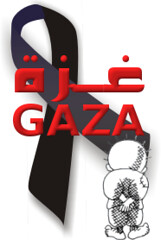Efforts to track communicable diseases in Gaza
Report, The Electronic Intifada, 28 April 2009
 |
| A point near the Beach refugee camp where sewage, either partially treated or not at all, runs into the sea. (Wissam Nassar/IRIN) |
GAZA CITY, occupied Gaza Strip (IRIN) - UN agencies and the health ministry in Gaza are working to strengthen communicable disease surveillance systems in Gaza, in light of the fact that leaking sewage may be contaminating drinking water.
The fragile water and sewage network was damaged during the recent 23-day Israeli offensive in Gaza, increasing public health risks, according to a recent report by the Water, Sanitation and Hygiene (WASH) cluster, entitled A Brief Outline of the Sewage Infrastructure and Public Health Risks in the Gaza Strip for the World Health Organization (WHO).
The WASH group, led by the UN Children's Fund (UNICEF), coordinates the humanitarian response by local and international organizations and UN agencies active in the water and sanitation sector in the West Bank and Gaza Strip.
"WHO is now analyzing if the risk of outbreak of waterborne and food-born diseases in Gaza is still high," said Mahmoud Daher, WHO officer in Gaza, explaining that the risk was high during the conflict because drinking water was not being properly chlorinated due to movement restrictions.
"During the recent war there was a mixing of drinking water with raw sewage in the Sheikh Ajleen area of Gaza City and in Beit Hanoun after a waste water carrier in Gaza City and a water and waste water carrier in Beit Hanoun were destroyed by Israeli forces during the first week of the war," said Coastal Municipal Water Utility (CMWU) director Monther Shoblak.
CMWU has asked WASH to carry out a comprehensive year-long survey on the underground water in Sheikh Ajleen and Beit Hanoun. WASH is structuring the project, said WASH director Graham Henderson in Gaza.
About 32,000 Palestinians live in Beit Hanoun and about 410,000 in Gaza City.
Two other high risk areas are Khan Younis and Beit Lahiya where the sewage system is leaking, potentially contaminating drinking water, WASH and WHO in Gaza reported.
Nitrates
"The relatively high nitrate level in well water in Gaza may be related to sewage infiltration from waste water treatment plants," said Henderson.
Nitrates are considered a dangerous water pollutant -- potentially carcinogenic -- according to Shoblak, and most threatening for children under six months old.
"Seventy percent of the drinking water samples tested over the past two years in the health ministry lab have shown nitrate levels higher than WHO standards [50 milligrams of nitrates per liter]," said WHO officer Daher.
New project proposed
WASH is supporting the WHO and Gaza health ministry in preventing major outbreaks of disease, and is proposing an emergency project -- estimated at $1 million -- to strengthen and monitor health ministry disease surveillance systems across the Strip, said Henderson, including surveillance by the health clinics and labs that perform testing for the health ministry to diagnose illnesses and measure water quality.
"Food and water monitoring by the health ministry resumed post-conflict, although the system is negatively affected by the long-term border closures and the subsequent lack of necessary materials," said Daher.
The UN agency for Palestine refugees (UNRWA) in Gaza operates a long-standing clinic surveillance system through 20 reporting units at health centers in Gaza, according to WASH.
Fifty-four primary healthcare clinics and 13 hospitals under the health ministry, and 30 primary healthcare clinics and 14 hospitals run by NGOs or privately require a stronger disease surveillance system, say WHO officials in Gaza.
About 80,000 cubic meters of raw sewage is being discharged into the Mediterranean at six main points along Gaza's coast every day, presenting a major health risk to the Gaza population, according to the WASH report.
This item comes to you via IRIN, a UN humanitarian news and information service, but may not necessarily reflect the views of the United Nations or its agencies. All IRIN material may be reposted or reprinted free-of-charge; refer to the copyright page for conditions of use. IRIN is a project of the UN Office for the Coordination of Humanitarian Affairs.












